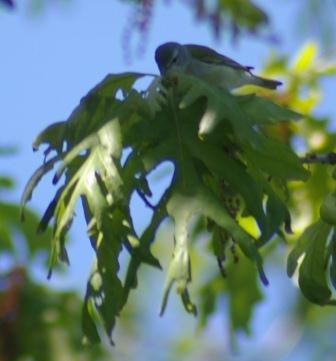by Carl Strang
The Tennessee warbler is one of our more abundant migrants, conspicuous more by sound than by sight in spring as it is well camouflaged and moves slowly, often high in the trees. It often works closer to the ground and more frenetically in the fall.
Warbler, Tennessee
Seen as migrant in many locations in the eastern U.S. Judging by songs, one of the most abundant warbler migrants. Not an easy bird to see; moves slowly and infrequently, and colors cryptic among tree leaves. Song loud and distinctive, and for a week or so every spring the trees of woods and residential areas ring with their songs. “Sebit, sebit, sebit, sebit, seteeteeteeteetee…” Initial part just like Nashville warbler’s, but last part very loud, rapid and energetic with no slurring of notes.
10MY87. First of season noted.
13MY87. At Willowbrook, one bird thoroughly working one small area, with much turning of its head, short reaches to probe nearby leaves, short hops between branches, relatively slow-moving for a warbler. Also does a lot of slow smooth stepping along a twig. Foraging in box elder, black willow.
13SE87. West DuPage Woods Forest Preserve. Several Tennessee warblers together in a mixed flock with a magnolia warbler, a red-eyed vireo, a female rose-breasted grosbeak, and several catbirds and robins. The warblers remained within 10 feet of the ground, active and acrobatic, probing, changing perches frequently (2-10 seconds), very chickadee-like and unlike last spring. 11MY88. First Tennessee warbler song of the year. Gone by May 20.
18MY90. Lots of Tennessee warblers at Willowbrook. Cold spring. The only warblers heard on the 24th.
4MY99. First migrant noted at Willowbrook. Last noted there on 25MY.
12MY99. Slow and deliberate, on 1 perch a long time as they look around.
31AU99. First migrant noted at Willowbrook. First-year Tennessee warbler very yellow, with yellow eye line, but white under tail. In contrast to spring birds, very frequent perch changes, actively pivoting and reaching. Last migrant at Willowbrook noted 17SE.
7MY00. Several Tennessees in a mixed flock at West DuPage Woods, high in canopy. One was moving steadily when I first saw it, foraging and singing, then was still for over a minute on a perch, apparently doing no foraging, but alternating singing with bouts of preening.
24SE00. Tennessees have been abundant, lately. Today, a couple in hedgelike borders of the Prairie Path at West Chicago Prairie just east of Industrial Drive.
8OC00. A couple Tennessee’s at West Chicago Prairie.
12OC02. A few at Fermilab in old field areas.

Leave a comment